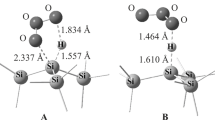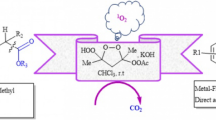Abstract
The yield of singlet oxygen (1O2) due to the degradation of triethylsilane, dimethylphenylsilane, triphenylsilane, and dimethyl(trimethylsiloxy)silane hydrotrioxides has been determined for the first time using the IR chemiluminescence technique. The most effective sources of singlet oxygen in this series are triphenylsilyl hydrotrioxide and dimethyl(trimethylsiloxy)silyl hydrotrioxide. The yield of 1O2 upon their degradation is 69 and 92%, respectively.
Similar content being viewed by others
Explore related subjects
Discover the latest articles, news and stories from top researchers in related subjects.Avoid common mistakes on your manuscript.
INTRODUCTION
The search for new sources of singlet oxygen and their study has been of interest to researchers over the years [1–6]. Chemical sources that make it possible to generate singlet oxygen in organic media with sufficient efficiency and, hence, are the most promising in organic synthesis are few. First of all, these are phosphite ozonides and hydrotrioxides, which can be easily synthesized by low-temperature ozonation. Triphenylphosphite ozonide is one of the reference sources of 1O2, since its thermal degradation produces singlet oxygen in quantitative yield [7]. The thermolysis of hydrotrioxides containing germanium or silicon atoms is also accompanied by the formation of singlet oxygen, the yield of which is 25–70%, as determined by the consumption of typical singlet oxygen scavengers (1,3-diphenylisobenzofuran, tetraphenylcyclopentadienone, 9,10-dimethylanthracene) [8–13]. It was shown that the decomposition of triethylsilyl hydrotrioxide is accompanied by chemiluminescence in the IR spectral region at λ = 1270–1277 nm [14], which is characteristic of radiative deactivation of the 1∆g state of singlet oxygen [15, 16], but the yield of 1O2 was not determined.
Previously, we used the chemiluminescence technique to study the kinetics of thermal degradation of a number of organic hydrotrioxides and determine the yield of singlet oxygen upon their decomposition [17]. In this work, we use the IR chemiluminescence technique to determine the yield of singlet oxygen produced by degradation of a number of silyl hydrotrioxides in dichloromethane.
EXPERIMENTAL
Commercial silanes (triethylsilane (1), dimethylphenylsilane (2), triphenylsilane (3), dime-thyl(trimethylsiloxy)silane (4)) available from Fluka/Aldrich and having purity of >95% (by GLC) were used without further purification. Dichloromethane was purified according to a standard procedure and dried over molecular sieves 4 Å. Ozone was obtained using an ozonizer of standard design [18]. The concentration of ozone in the gas phase was ~1.75 mmol/L. Triphenylphosphite ozonide was obtained according to the procedure described in [19]. Triphenylphosphite ozonide was analyzed using the 31P NMR technique (H3PO4 standard).
Silane hydrotrioxides were prepared at a temperature of 183 K by passing a cooled ozone–oxygen mixture through a 0.038–0.2 M solution of the corresponding silane in CH2Cl2. The ozonation time was 3–14 min. The concentrations of hydrotrioxides and triphenylphosphite ozonide were determined according to the standard procedure with triphenylphosphine [17]. NMR spectra were recorded on a Varian Mercury-500 spectrometer, which allows recording spectra at low temperatures down to 183 K.
Chemiluminescence in the IR region was recorded using a highly sensitive setup [17] with an FEU-83 photomultiplier tube cooled with a nitrogen flow to 183 K. The emission region of singlet oxygen was isolated with an IKS-7 cutoff filter (λ > 900 nm). The chemiluminescence measurement setup was calibrated using a source with a known yield of singlet oxygen (Ф)—triphenylphosphite ozonide, for which Ф = 1.0 [7]. All experiments to determine the yield of singlet oxygen were performed with maintaining constant parameters, such as geometry and volume of the reactor, total volume of the reaction mixture, voltage applied to the photomultiplier (1.6 kV), and its temperature. The yield of singlet oxygen was calculated according to the procedure described in [20].
RESULTS AND DISCUSSION
The low-temperature (183 K) ozonation of triethylsilane (1), dimethylphenylsilane (2) triphenylsilane (3), and dimethyl(trimethylsiloxy)silane (4) in dichloromethane results in the corresponding hydrotrioxides (1a–4a) identified by 1H NMR spectroscopy according to a signal characteristic of hydrotrioxides at δ 12–14 ppm, which corresponds to the proton of the –OOOH group [13, 21] and disappears irreversibly after heating to room temperature. For silane 4, synthesized for the first time, the signal was observed at δ 14.02 ppm (198 K, acetone-d6).
The thermal degradation of triorganosilane hydrotrioxides is accompanied by IR chemiluminescence with a maximum at ~1270 nm. The chemiluminescence during the reaction of thermal decomposition of hydrotrioxides 1a–4a was studied in dichloromethane at 248 K. The hydrolysis of silane hydrotrioxides to give silanol and hydrogen hydrotrioxide can be neglected in this case. This is due to the long half-life of hydrotrioxides in the hydrolysis reaction compared to the duration of the experiment, which was 20 min, while the half-life toward hydrolysis is about 10 h at 235 K according to 1H NMR data.
The rate curves of IR chemiluminescence during thermal degradation of silane hydrotrioxides are shown in Fig. 1. The IR chemiluminescence decay follows the first-order rate law; the calculated rate constants are given in Table 1. Silane hydrotrioxides are less stable than organic hydrotrioxides [22].
The yield of 1O2 upon thermal degradation of hydrotrioxides 1a–4a (Table 1) was determined using the chemiluminescence method. For the hydrotrioxides studied, it ranges from 33% for phenyldimethylsilane hydrotrioxide to 92% for dimethyl(trimethylsiloxy)silane hydrotrioxide. According to the data obtained using 9,10-dimethylanthracene as a scavenger of singlet oxygen, the 1O2 yield from 1a–3a was 70 ± 10% [13], a value that is in good agreement with our results, except for PhSi(Me2)OOOH. For the latter hydrotrioxide, the yield determined by chemiluminescence measurements is two times less, which can be explained by its lower steric hindrance and, hence, higher reactivity leading to overestimation of the results obtained by the scavenging technique, which is due to the direct reaction of the scavenger with hydrotrioxide. In the case of thermal degradation of hydrotrioxides of hydrocarbons, the yield of singlet oxygen does not exceed 15% (1,4-dimethylcyclohexyl hydrotrioxide, 15°С, dichloromethane) [23, 24]. The replacement of carbon with silicon in the hydrotrioxide moiety has a significant effect on the yield of singlet oxygen produced by their degradation; this effect is apparently due to enhanced stability of the radical complex [R3SiO• HOO•], which increases the likelihood of retaining the biradical pair in the singlet state, in comparison with the carbon-containing analogue.
CONCLUSIONS
The yield of singlet oxygen O2 (1∆g) during the degradation of silane hydrotrioxides—triethylsilane, dimethylphenylsilane, triphenylsilane, and dimethyl (trimethylsiloxy) silane—has been determined using the IR chemiluminescence technique. The 1O2 yield is comparable to or higher than that for organic hydrotrioxides. The values for the 1O2 yield obtained previously for silyl hydrotrioxides are overestimated because the direct reaction of scavengers with hydrotrioxides was not taken into account.
REFERENCES
Miyata, Sh., Yamada, T., Isozaki, T., Sugimura, H., Xu, Ya.-Z., and Suzuki, T., Photochem. Photobiol., 2018, vol. 94, no. 4, p. 677. https://doi.org/10.1111/php.12900
Westberg, M., Bregnhøj, M., and Etzerodt Ogilby, P.R., J. Phys. Chem. B, 2017, vol. 121, no. 12, p. 2561. https://doi.org/10.1021/acs.jpcb.7b00561
Solovieva, A.O., Kirakci, K., Ivanov, A.A., Kubát, P., Pozmogova, T.N., Miroshnichenko, S.M., Vorontsova, E.V., Chechushkov, A.V., Trifonova, K.E., Fufaeva, M.S., Kretov, E.I., Mironov, Yu.V., Poveshchenko, A.F., Lang, K., and Shestopalov, M.A., Inorg. Chem., 2017, vol. 56, no. 21, p. 13491. https://doi.org/10.1021/acs.inorgchem.7b02212
Prado, F.M., Oliveira, M.C.B., Miyamoto, S., Martinez, G.R., Medeiros, M.H.G., Ronsein, G.E., and Di Mascio, P., Free Radical Biol. Med., 2009, vol. 47, no. 4, p. 401. https://doi.org/10.1016/j.freeradbiomed.2009.05.001
Fudickar, W. and Linker, T., Org. Chem., 2017, vol. 82, no. 17, p. 9258. https://doi.org/10.1021/acs.joc.7b01765
Jary, W.G., Ganglberger, T., Pöchlauer, P., and Falk, H., Monatsh. Chem., 2005, vol. 136, no. 4, p. 537. https://doi.org/10.1007/s00706-004-0251-1
Cominade, A., Khatib, F., and Koenig, M., Can. J. Chem., 1985, vol. 63, p. 3203.
Ouellette, R.J. and Marks, D.L., J. Organomet. Chem., 1968, vol. 11, p. 407.
Spialter, L., Pazdernik, L., Bernstein, S., Swansiger, W.A., Buell, G.R., and Freeburger, M.E., Adv. Chem. Ser., 1972, vol. 112, p. 65.
De Meijere, A. and Wolf, F., Methoden der organische Chemie, Kropf, H., Ed., Stuttgart: Wiley, 1988, E13 Teil 1, p. 971.
Plesničar, B., Organic Polyoxides, Ando, W., Ed., Chichester: Wiley, 1992, p. 479.
Plesničar, B., Cerkovnik, J., Koller, J., and Kovač, F., J. Am. Chem. Soc., 1991, vol. 113, no. 13, p. 4946. https://doi.org/10.1021/ja00013a034
Cerkovnik, J., Tuttle, T., Kraka, E., Lendero, N., Plesničar, B., and Cremer, D., J. Am. Chem. Soc., 2006, vol. 128, no. 12, p. 4090. https://doi.org/10.1021/ja058065v
Corey, M.E.J., Mehrotra, M., and Khan, A.U., J. Am. Chem. Soc., 1986, vol. 108, no. 9, p. 2472. https://doi.org/10.1021/ja00269a070
Wu, H., Song, Q., Ran, G., Lu, X., and Xu, B., Trends Anal. Chem., 2011, vol. 30, no. 1, p. 133. https://doi.org/10.1016/j.trac.2010.08.009
Bregnhøj, M., Westberg, M., Minaev, B.F., and Ogilby, P.R., Acc. Chem. Res., 2017, vol. 50, no. 8, p. 1920. https://doi.org/10.1021/acs.accounts.7b00169
Khalitova, L.R., Antipin, A.V., Grabovskii, S.A., and Kabal’nova, N.N., High Energy Chem., 2018, vol. 52, no. 5, p. 446.
Vendillo, V.P. and Emel’janov, Yu.M., Zavod. Lab. (USSR), 1959, p. 1401.
Thompson, Q., J. Am. Chem. Soc., 1961, vol. 83, no. 4, p. 845. https://doi.org/10.1021/ja01465a027
Khursan, S.L., Khalizov, A.F., Avzyanova, E.V., Yakupov, M.Z., and Shereshovets, V.V., Russ. J. Phys. Chem., 2001, vol. 75, no. 7, p. 1107.
Koenig, M., Barrau, J., and Hamida, N.B., J. Organomet. Chem., 1988, vol. 356, p. 133.
Shereshovets, V.V., Khursan, S.L., Komissarov, V.D., and Tolstikov, G.A., Usp. Khim., 2001, vol. 70, no. 2, p. 123.
Avzyanova, E.V., Timerghazin, Q.K., Khalizov, A.F., Khursan, S.L., Spirikhin, L.V., and Shereshovets, V.V., J. Phys. Org. Chem., 2000, vol. 13, no. 2, p. 87.
Khursan, S.L., PATAI’s Chemistry of Functional Groups: The Chemistry of Peroxides, Greer, A. and Liebman, J.F., Eds., Chichester: Wiley, 2014, vol. 3, part 2, p. 125.
Author information
Authors and Affiliations
Corresponding author
Additional information
Translated by S. Zatonsky
Rights and permissions
About this article
Cite this article
Khalitova, L.R., Grabovskii, S.A. & Kabal’nova, N.N. Formation of Singlet Oxygen during Thermal Degradation of Hydrotrioxides of Triorganosilanes. High Energy Chem 53, 435–437 (2019). https://doi.org/10.1134/S0018143919060109
Received:
Revised:
Accepted:
Published:
Issue Date:
DOI: https://doi.org/10.1134/S0018143919060109





